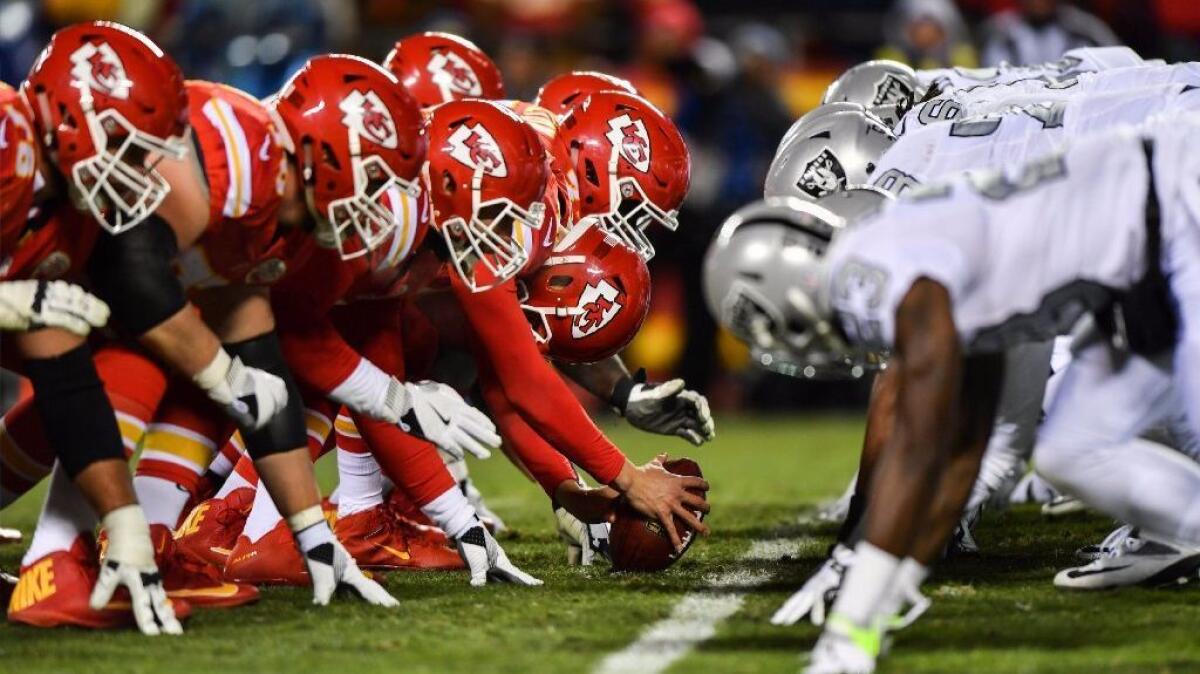Ask Farmer: Why is the center allowed to move the ball forward before the snap?

- Share via
Have a question about the NFL? Ask Times NFL writer Sam Farmer, and he will answer as many as he can online and in the Sunday editions of the newspaper throughout the season. Email questions to: sam.farmer@latimes.com
Why is the center allowed to move the ball forward beyond where the umpire placed it when getting ready to snap? That practice seems like an illegal gain of several inches (sometimes up to six inches that I’ve seen) since the center’s position is used by the offensive line to figure where to line up.
Mike Shaw, Whittier
Farmer: The NFL rulebook reads: “No player of offensive team may charge or move abruptly, after assuming set position, in such manner as to lead defense to believe snap has started.” But that doesn’t address the center adjusting and sometimes moving the football before the snap. So I turned to Matt Birk, a retired All-Pro center (and Harvard alumnus) who played 15 seasons as a Viking and Raven. “You can move the ball quite a bit when you’re getting your grip and getting settled in,” Birk said. “As you get close to a potential snap, when the quarterback’s in his cadence, you have to be pretty still. There are times . . . when umpires will talk to you before the game and say, ‘Make sure the ball’s still.’ Because especially when you’re in silent count, defensive guys are only watching the ball. That’s all they have to go off of. But up until about two seconds before a potential snap, you have a lot of leeway.”
What about the tricks of the trade? Birk laughed. There were times he’d scream, “Set-hut!” — something that typically would only come from the quarterback — to try to get the defense to jump.
“You’ve got to make sure you aren’t tensing up when you yell that,” he said. “Any type of muscular contraction could cause the ball to move. You’re just kind of trying to fool the D-line. Just because they’ve repped it a million times, when they hear ‘Set-hut!’ they might just involuntarily come forward.”
Now, the real trick, one that gets to the root of your question.
“If you have third and inches or fourth and inches, and you kind of purposely get a little bit closer to the ball with your feet than you normally would, you can move the ball forward a little bit as you get down in your crouch. Essentially, you already have the first down before the ball is snapped. You just have to not lose yardage and you’ll get it.”
::
What’s to stop a kicker from taking a running start on a field goal?
Dave Stuart, Westlake Village
Farmer: Timing is the biggest concern, because the kicker can’t move forward before the ball is snapped. The more steps, the longer it takes to get the ball off, and the expected time from snap to kick is 1.28 seconds. The current configuration, with the holder eight yards back and the kicker three yards behind, is the accepted norm.
Conceded retired NFL kicker Michael Husted: “If there was a rule that allowed the kicker to move forward before the snap on a field-goal attempt, then there would be some longer kicks.”
Follow Sam Farmer on Twitter @LATimesfarmer
More to Read
Go beyond the scoreboard
Get the latest on L.A.'s teams in the daily Sports Report newsletter.
You may occasionally receive promotional content from the Los Angeles Times.










